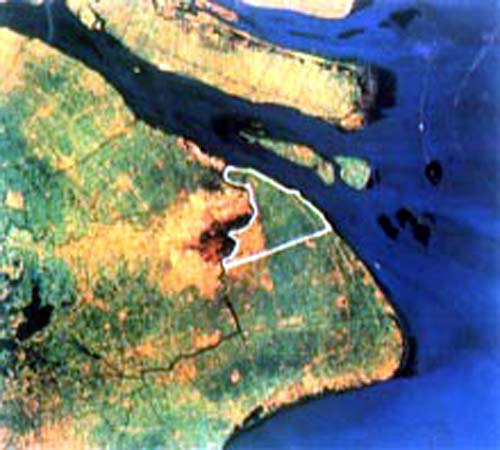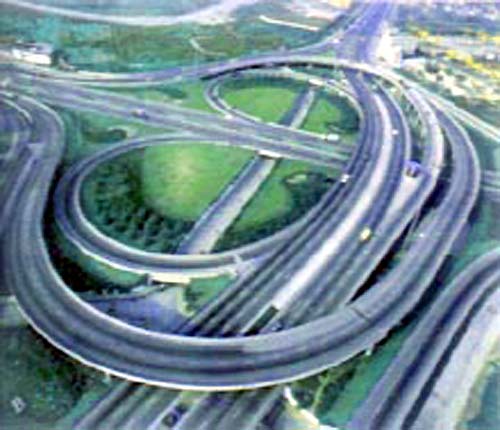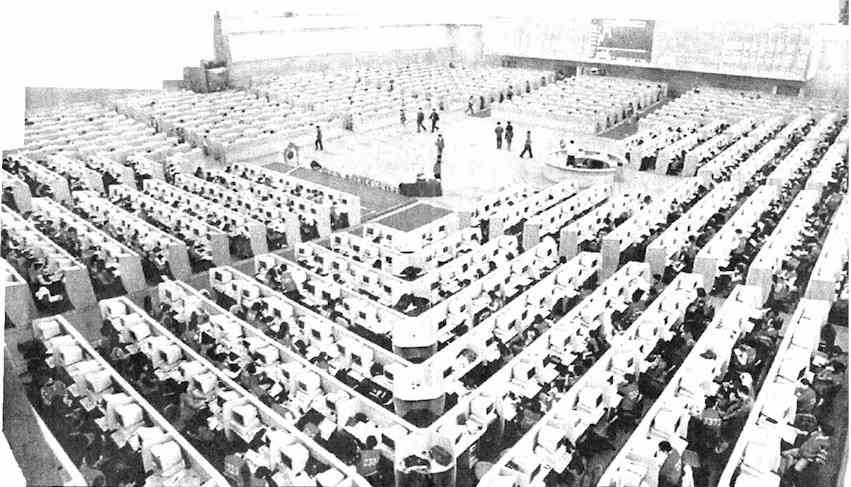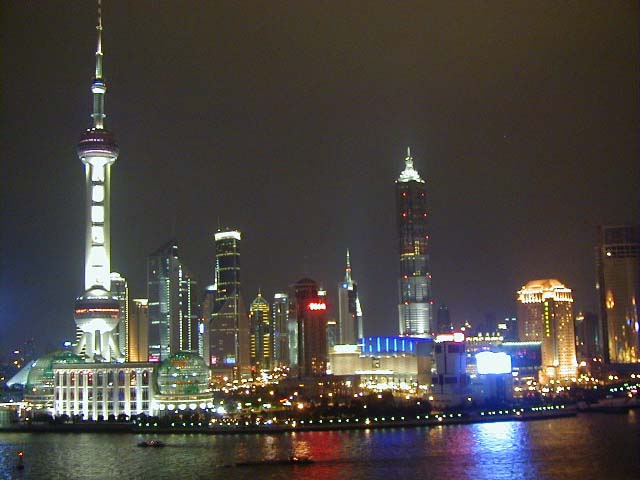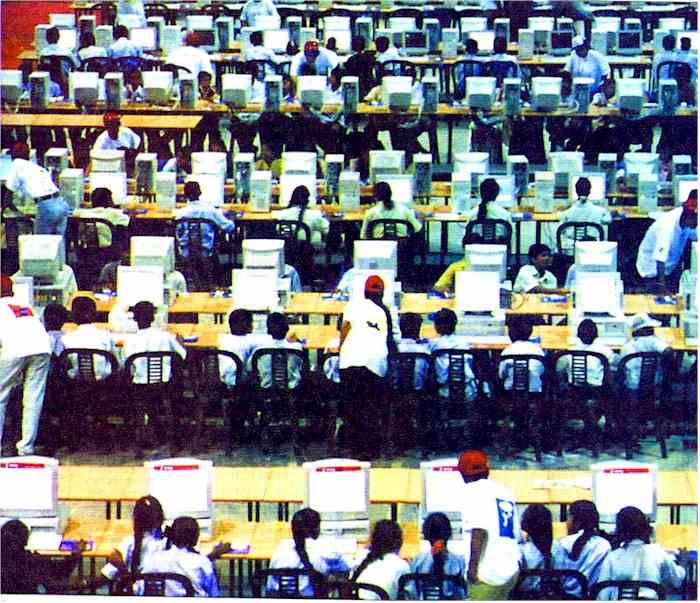Digital Divide
Wheeling and Dealing in ShanghaiThe digital revolution is far more significant than the invention of writing or even of printing. - Douglas Engelbart by Xu Xun Many world-famous cities feature their own economies and cultures. Shanghai, the largest economic centre in China, has been known as a centre for commerce and for the blending of Western and Oriental cultures. Today, Shanghai has set a new goal: to build itself into an international centre for economy, finance, and trade in the 21st century. To reach the goal, they feel that it is vital to develop Pudong. The Pudong New District is named for its location: east ("dong") of the Huangpu River, the last tributary flowing into the Changjiang (Yangtze) River. The Huangpu flows through Shanghai, cutting the city into east and west. The Pudong New District is shaped like a triangle consisting of the eastern bank of the Huangpu, the southwestern part of the mouth of the Changjiang, and the northern bank of the Chuanyang River.
A satellite image of Pudong and Shanghai. The Pudong New District covers 522 square kilometers and touches the Changjiang in the northeast, Hangzhou Bay in the south, and the Huangpu in the west, thus enjoying favourable conditions for the construction of a harbour and for water transportation. It has a large area for further development, an advantage seen in few other coastal areas in East China. Ten years of unremitting effort have greatly improved the infrastructure in Pudong. The construction of the Inner Ring Road, Yanggao Road, the Century Boulevard, the No. 2 underground railway across the Huangpu River, the Pudong International Airport, the Pudong International Information Centre, the Waigaoqiao Power Plant, and the first phase of the Pudong Deep-Water Port has not only improved the investment environment but also helped form a modern new multi-function district with a foreign-oriented production.
The overpass at Longyang Road in Pudong. To develop modern industries, Pudong will focus on high technology, including electronics, information science, bio-pharmacy, and new materials. Today, Pudong has a hi-tech district covering 60 square kilometers. The district has so far attracted Umore than 6,000 projects from 67 countries and regions, thus acquiring one of the densest concentrations of capital in the world. Finance in Shanghai is large scale, concentrated, and foreign oriented and is of various kinds. The best example is the Lujiazui Financial and Trade District in Pudong. The district covers an area of 28 square kilometres, and has nearly 200 high-rises providing space to 78 Chinese and foreign financial institutions. The Shanghai Stock Exchange, the largest stock exchange in China, moved to Lujiazui, with listed companies in 31 provinces, autonomous regions, and municipalities. Today, the stock markets in Shanghai have become important centres for fund raising and information service.
The modern Shanghai Stock Exchange, hoping to regain the place it held as one of the world's most dynamic trading floors before the Communists took
over In the near future, Pudong will be built into the largest financial centre in Asia. The Lujiazui Development Company has built a group of residential areas equipped with facilities for culture, entertainment, sports, and education to suit the overall development plan for Lujiazui, thus offering attractive living conditions for investors from China and abroad. Today, more than 160 households from Hong Kong and Taiwan and from 20 countries including the United States, Canada, Germany, Sweden, Switzerland, Japan, South Korea, Singapore, and Malaysia have turned the residential areas into an international village.
Pudong at night. Source: www-scf.usc.edu Source: china-pictorial.com photographs by Chen Shilin, Sun Weizhong and Xu Xun (unless specified otherwise)
Poorer Countries Look to High-Tech Alternatives
India's booming high-tech sector contributes to a growing interest in computers, seen here in a Bangalore Internet promotion Rapid global developments in information and communication technology offer poor countries the opportunity to leapfrog stages in traditional economic development. But it also has the potential to worsen the gap between the rich and poor of the world, an international report says. The International Labour Office published its World Employment Report 2001: Life at Work in the Information Economy earlier this year. The ILO is an international humanitarian labour movement, established in 1919 and winner of the Nobel peace prize in 1969. Because of the different speed of dispersion of information and communications technology in wealthy and poor countries, the information and communications technology (ICT) revolution is resulting in a widening global "digital divide". The report says that unless this is addressed urgently, the employment opportunities and productivity potential of millions of workers in scores of developing countries will not be realised. "The ICT revolution offers genuine potential but also raises the risk that a significant portion of the world will lose out," ILO director-general Juan Somavia says. The report says that ICT can have a far-reaching impact on the quality of life of workers in poorer countries if the right policies and institutions are in place and serve as important spurs to development and job growth. In some cases, the high mobility of ICT capital and its knowledge-based nature may allow lower income countries to "leapfrog" stages in traditional economic development via investments in human resources. For this to occur, three requirements are vital: a coherent national strategy toward ICT, the existence of an affordable telecom infrastructure, and the availability of an educated workforce. Countries and regions that fail to make the technological leap risk not only missing out on the large and growing trade in information and communications technology products but will be unable to profit from the economic efficiency and productivity gains that derive from these industries, the report says. Only some countries in eastern Asia appear to be keeping up with the developed countries in the spread of technological progress. The economies of China, Malaysia, Thailand, Philippines and others, for example, have been able to make rapid progress in hi-tech areas and were able to capture a significant share of the world market for semiconductors and other data-processing equipment. Beyond hardware production, however, one factor that appears essential to the entry of countries into the hi-tech digital world is the development of a domestic skill base in software production and use. India has seen its software sector grow by 50% throughout the 1990s, creating not just exports but thousands of domestic jobs and a technological talent pool that is drawing international attention from industrialised countries and large multinationals. Costa Rica has drawn some of the world's largest ICT companies seeking to employ its relatively educated workforce in a development effort that has seen jobs created and exports increase and is now spawning a domestic software industry in the Central American nation. Even where export opportunities in the ICT sector prove elusive, gains from access to the technology it generates can promote jobs and entrepreneurship in such industries as data processing and call centres. In Africa's Senegal, liberalisation of telecommunications regulations has spawned a host of "telecentres" providing access to telecommunications and creating thousands of jobs. And in South Africa, the growth of such telecentres has provided unprecedented access to public services, as well as vital information on health care, social benefits and other government services. ICT can also be made relevant to the objective of poverty reduction, not just through its effect on economic growth, but also through improving access to health care, education and other social services. Public and/or private assistance to community-based organisations to provide access tailored to the needs of poor persons is one place to begin. The report also finds that patterns of gender segregation are being reproduced in the information economy. The most striking digital gender divide relates to Internet use, with women in the minority of users in both developed and developing countries. Most Internet users are male, college-educated and earn higher-than-average incomes. For example, only 38% of Internet users in Latin America are women, while in the European Union the figure is 25%, in Russia 19%, in Japan 18% and in the Middle East four percent. Only where Internet access is well developed, for example in Scandinavia and the United States, has the gender gap in the use of the Internet closed. The report says that although pay inequality exists between those who have ICT skills and those who do not, pay polarisation also exists within ICT use itself. This polarisation is often gender-based. However, women in India have increased their share to 27% of professional jobs in the software industry, while in the Caribbean and many other countries, in the 1990s thousands of women obtained jobs in the data processing sector. In Uganda, women who have lost family to Aids weave traditional baskets as part of the Sapphire Women group which sells the products on the Internet with the help of a US-based non government organisation. Source: The Evening Post Wednesday 4 April 2001 photo credit Reuters
Also see:
For IT-related articles on snooping, usage, the future, e-diaries, piracy, flickers, cyborgs, browsing, trends, jokes, philosophic agents, artificial consciousness and more, press
the "Up" button below to take you to the Table of Contents for this Information and Technology section. |
 Animals
Animals Animation
Animation Art of Playing Cards
Art of Playing Cards Drugs
Drugs Education
Education Environment
Environment Flying
Flying History
History Humour
Humour Immigration
Immigration Info/Tech
Info/Tech Intellectual/Entertaining
Intellectual/Entertaining Lifestyles
Lifestyles Men
Men Money/Politics/Law
Money/Politics/Law New Jersey
New Jersey Odds and Oddities
Odds and Oddities Older & Under
Older & Under Photography
Photography Prisons
Prisons Relationships
Relationships Science
Science Social/Cultural
Social/Cultural Terrorism
Terrorism Wellington
Wellington Working
Working Zero Return Investment
Zero Return Investment